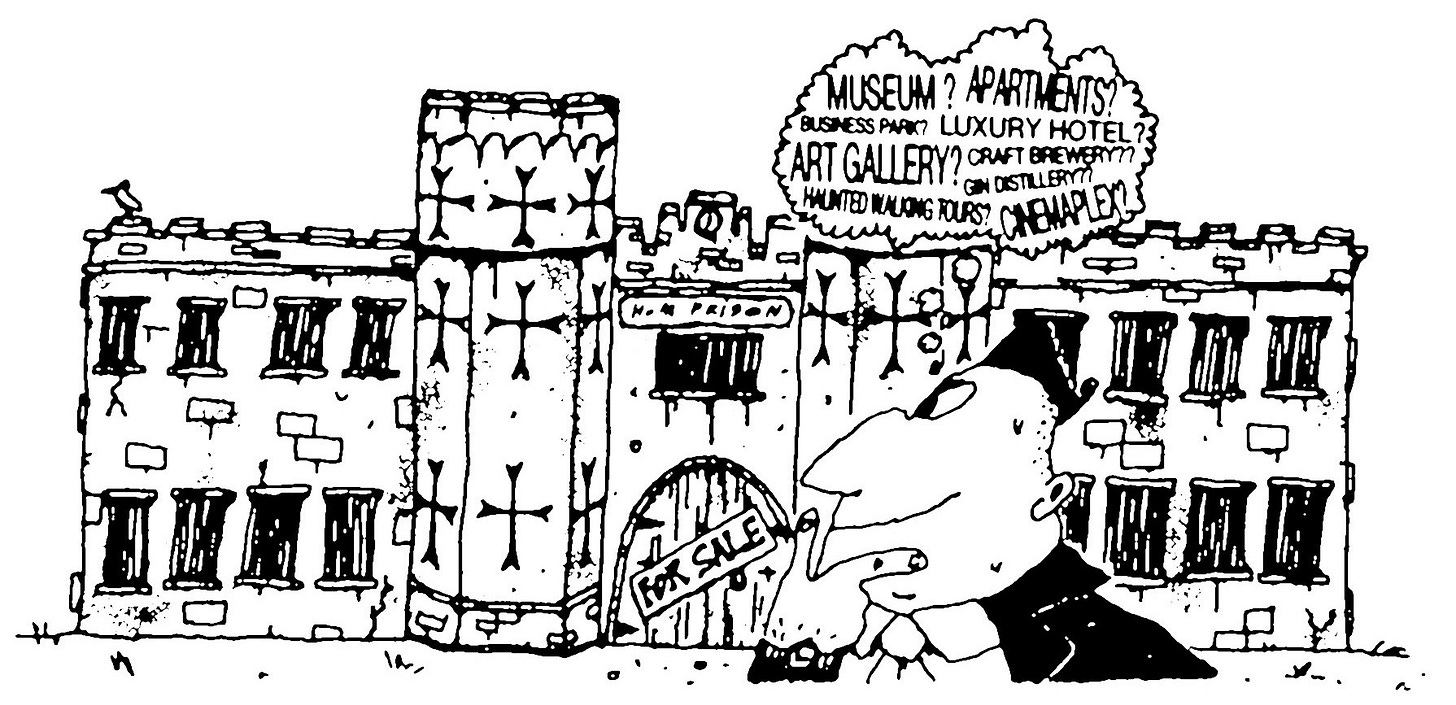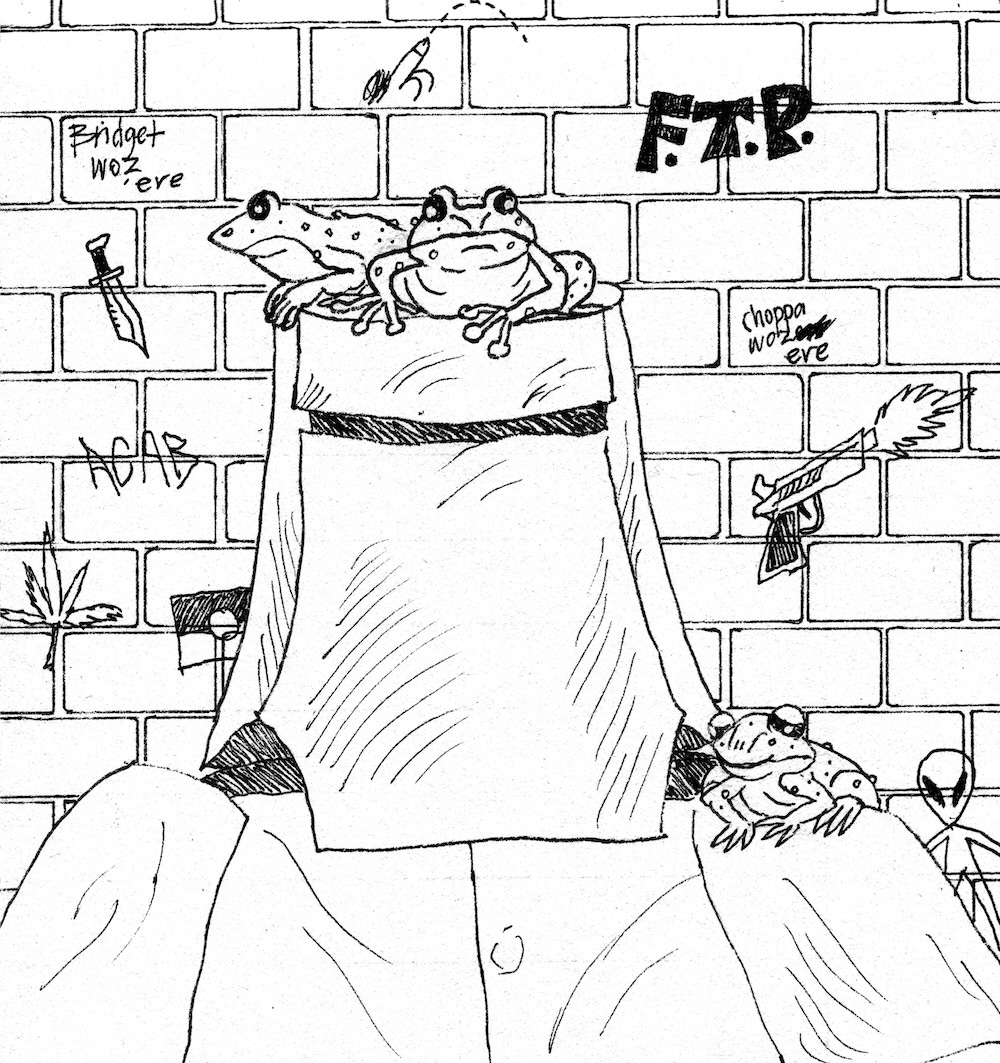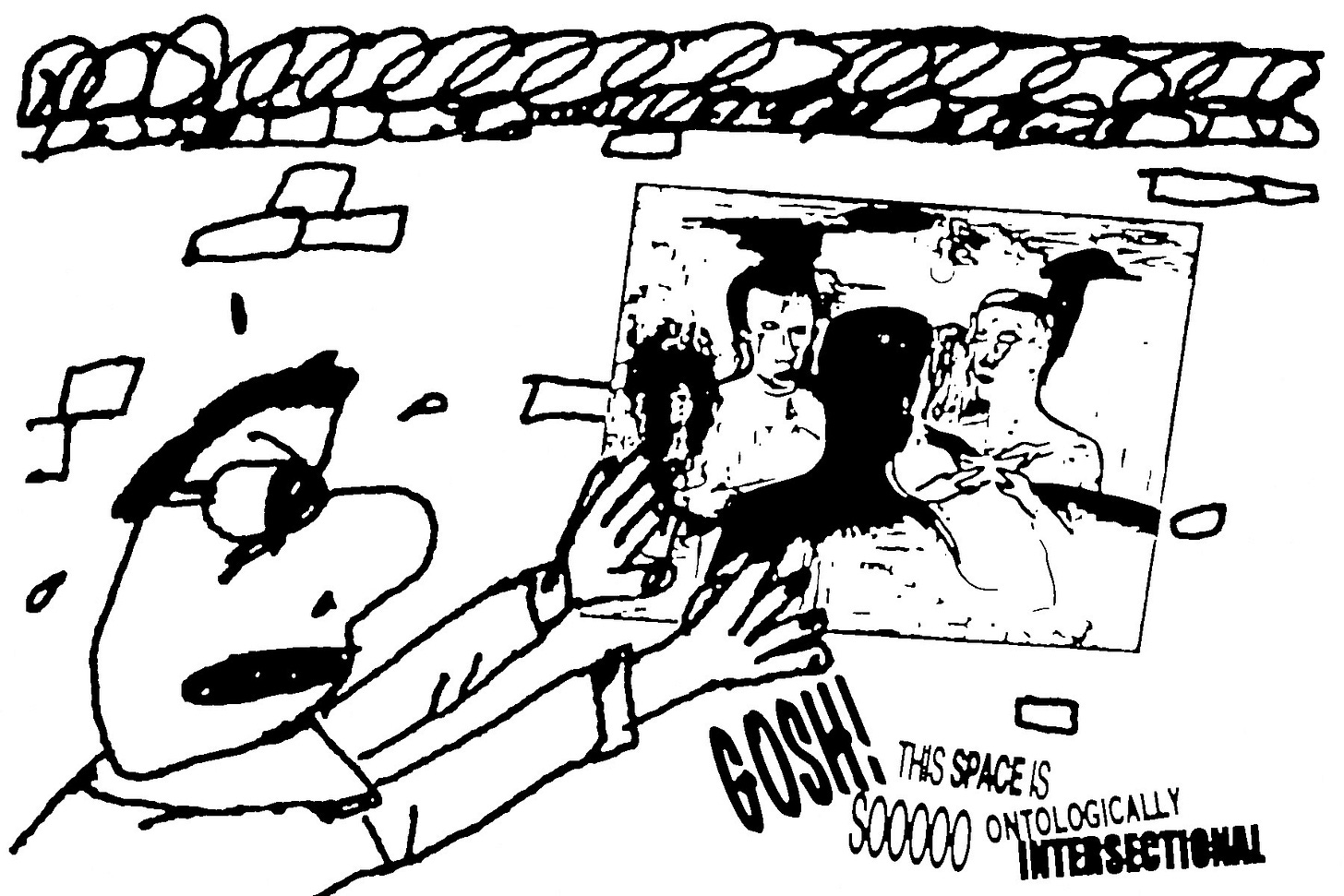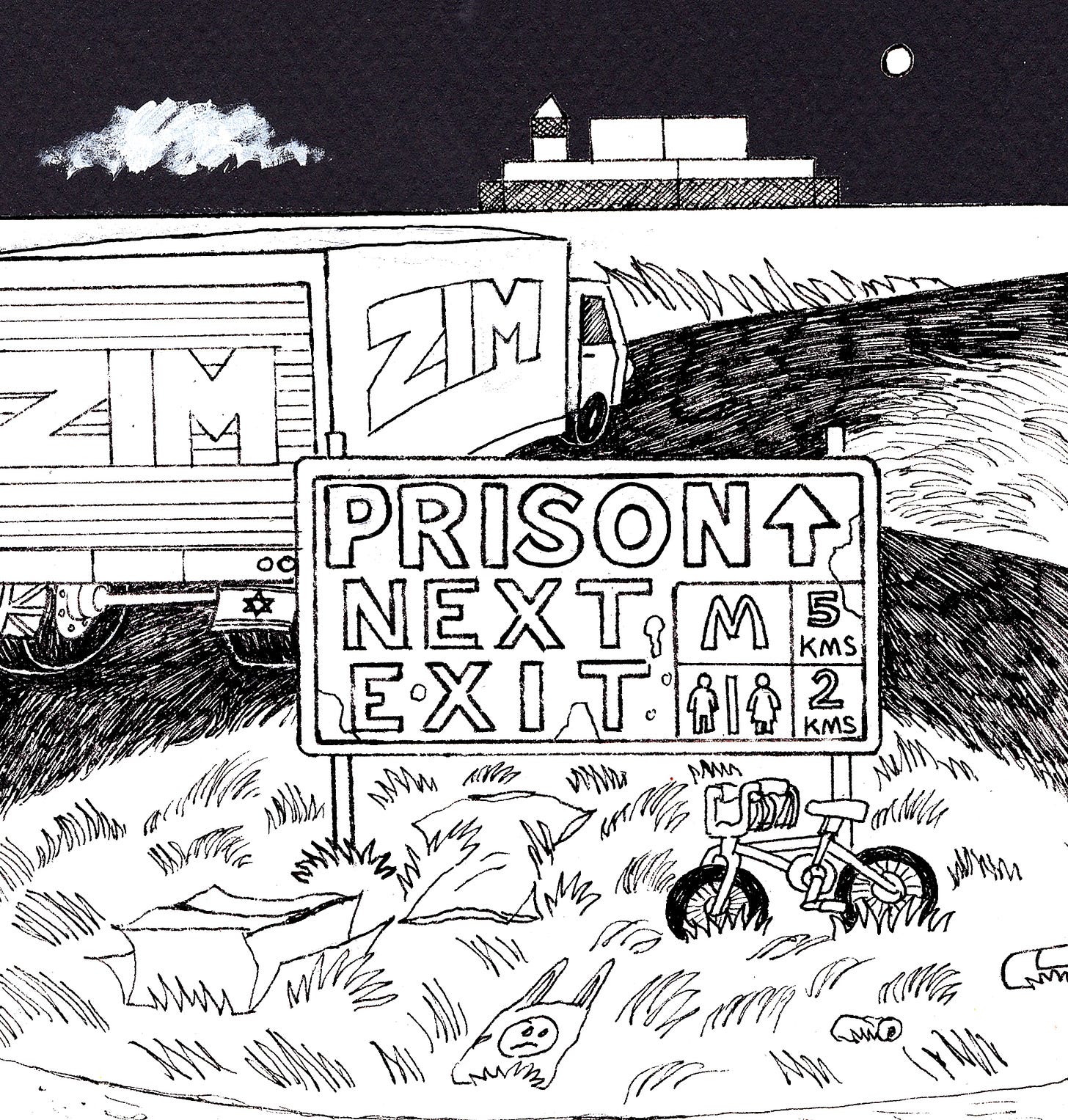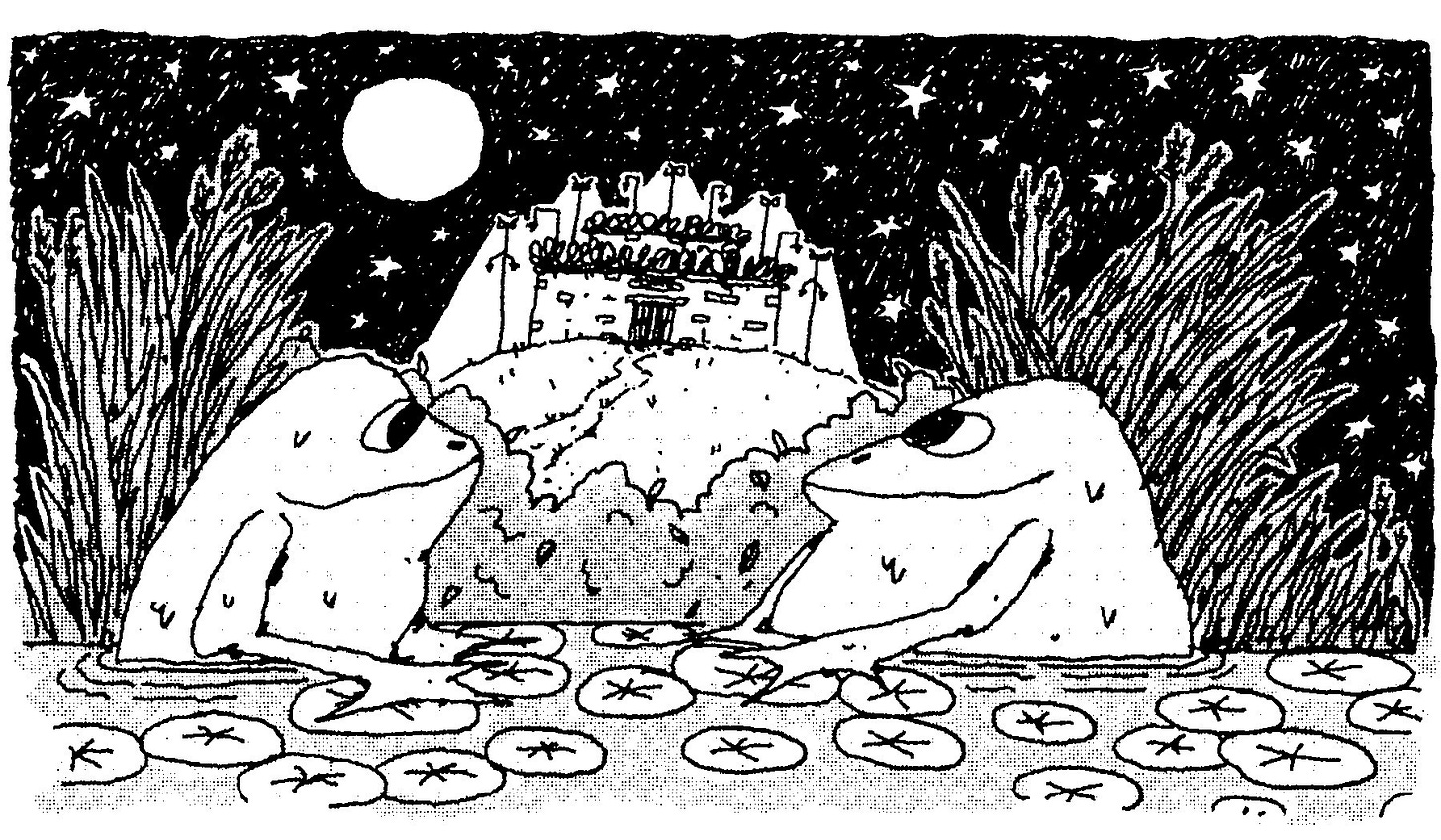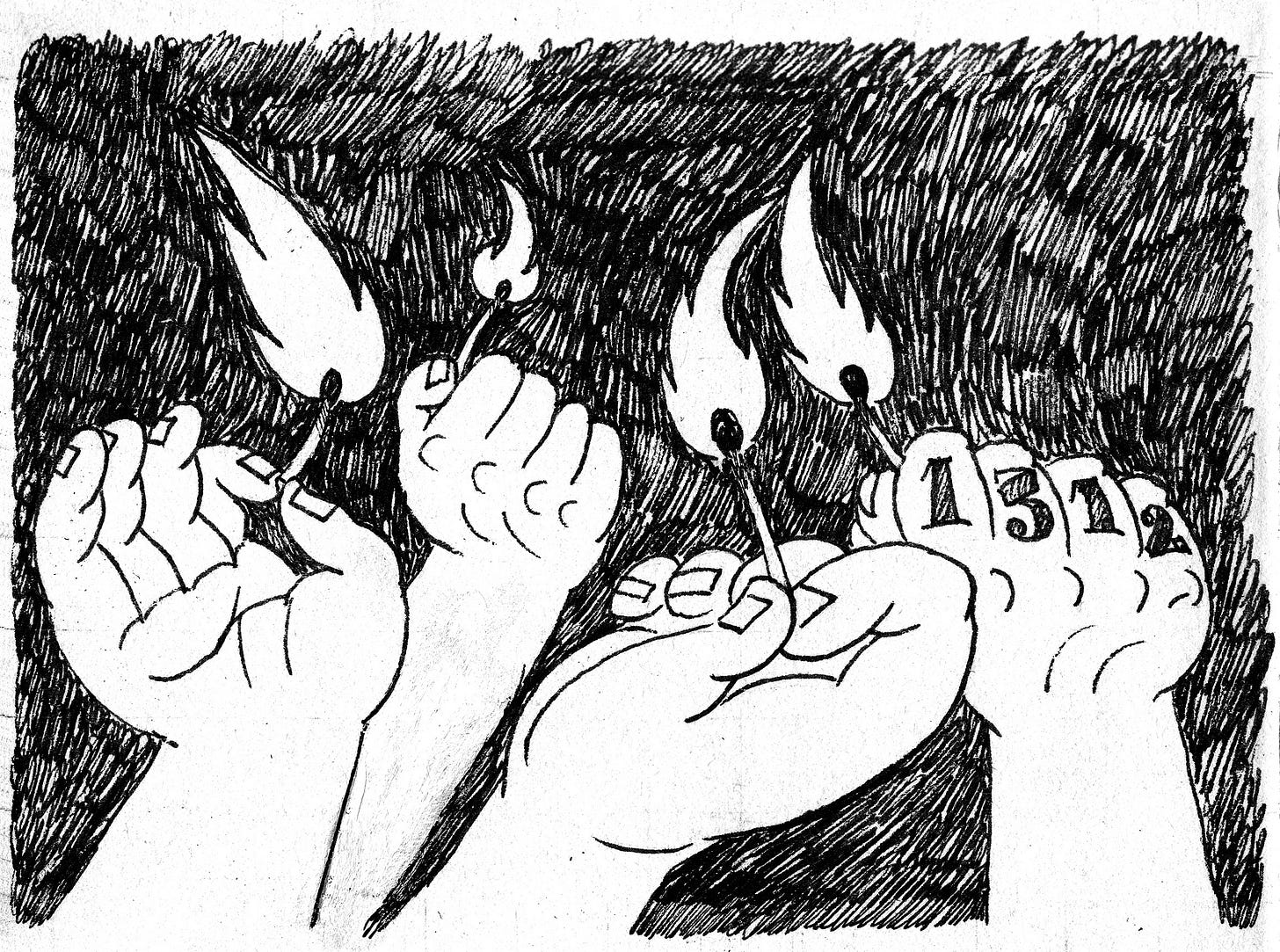#4. Trauma-informed capitalism
Words by Bridget Chappell, illustrations by Dominic Sargent and Grant Gronewold.
A few years ago I did a residency at Fremantle Arts Centre, or as the site used to be called, Fremantle Lunatic Asylum and Invalid Depot. This much I learned from a history brochure at the front desk on my first day, that talked up the colourful characters under its punitive control, be it practitioners of alcoholism or prostitution, or simply the elderly.1 For the first half of the twentieth century it then narrowed its scope as a women’s prison. Now, dividing walls had been knocked down to create galleries showcasing soft sculptures from women’s weaving collectives of the Kimberley, and spacious ceramics workshops for the yummy mummies who populated the grounds, orbiting the coffee cart. My studio retained its original dimensions as what was evidently a bedroom; a cell.
While connecting with extended family in Western ‘Australia’, it came out that a great aunt of mine had also been a resident there – not as an artist, but an inmate, during its women’s prison era. I came back from another lunch with people I didn’t know to my studio, wondering if it had been her old cell. Earlier that year I’d blurted out “I hate this” and exited a meeting at the Women’s Museum of Australia, housed in H.M. Gaol of Alice Springs. I worked at a local ARI2 (housed in an old petrol station, don’t come at me) and helped run a prisoner letter writing group there, which I suppose is why I was asked to come chat about, it turned out, residency programs in the women’s cell block. We were invited to check them out. “So much of the old graffiti is intact” the project manager enthused. I hovered at the door, feeling crazy, and left. Six months later, staring out through the barred windows of Fremantle Art Centre, the joke was on me. A creative practice is already an isolating headfuck, but that can’t be the only contributing thread to the phenomenon of detention centres repurposed as art centres.
We’re all aware of the prison-industrial complex, which goes something like: social investment in locking problematised people up equals big capital investment and bigger pay-offs for sectors like construction, tech, security, services and social work. The profit drive ensures its place in the pantheon of economic growth, which means more prisons, more prisoners, and more re-imprisonment of prisoners, despite some spin about rehabilitation. Australia’s obsession with preserving and reinvigorating its own paltry footprint of colonial heritage and the art sector’s insatiable need for space in which to make and experience work has given us the gaol-art industrial complex. Old detention centres deemed too historical to knock down but nonetheless awkward to repurpose (architecturally and spiritually) find a friend in the self-consciously liberal world of contemporary art and its tedious preoccupation with activating sites, its readiness to shoehorn artists’ practices into whatever chicken coop or asbestos pit is going, its calling something a spade to make it a spade charlatanism. Copy writers of the gaol-art industrial complex give vague homage to the site’s history, and noncommittal suggestion of its healing: the prison itself is somehow rehabilitated in its upcycling as an art gallery, tasked as it is with getting to the bottom of this human condition thing. The prison’s legacy is justified, the art’s place in the canon of history is secured.
Early colonial women’s prisons hold a particular portfolio of criminalisation: Indigeneity, sex work, hysteria and other old-timey menty b’s, immorality, and poverty. They live on as places like Abbotsford Convent in Narrm: the media packaging of the day was Catholic piety, prison labour in service of the commercial laundry. Women were renamed on admission (after whatever saint); if they were unmarried mothers, their children were usually taken away. The Convent shut up shop in the ‘70s. When a property developer looked set to build apartments there in the ‘90s, a community campaign was launched to “save” the site, including $3 million raised, 6,000 letters of objection from local residents – and so we have today’s cultural centre. NIMBYs3 mobilise for ye olde locke-uppe, but won’t stand for a modern descendent’s construction nearby. Art galleries rarely spark local shut-down campaigns, and have become the mask of choice for ageing carceral infrastructure.
What should happen to old prisons, then? Not much. My own brief stint behind bars in Ayalon Prison (Lod, ‘Israel’) only deepened what I already know: the only thing to do with decommissioned detention centres is dousing the entirety in gas and inviting everyone who’s done time there to simultaneously cast the first match. There are no recoupable losses here. Prison is a bunch of evil bullshit. No-one should ever experience it. Find me an ex-detainee keen for a site-specific installation in their old cell block that isn’t a petrol fire. Unless you’ve been sentenced or sectioned, how is repurposing one of these shitholes anything besides opportunism? Can art in an old prison ever lead to justice, or is it just trauma-informed capitalism?
Modern prisons prove more challenging to reuse – like modern everything, the asbestos era probably drew that line in the sand. Malmsbury Youth Justice Centre in central Victoria closed in December 2023 amidst bad press, a slew of “incidents”, and staff quitting en masse. Prisoners were moved to the conveniently just-opened Cherry Creek Youth Justice Centre, able to imprison more people than Malmsbury, and located in a key development corridor between outer west Melbourne and Geelong. Malmsbury’s closure was contested in state Parliament, with queries regarding the Labor government’s decision to close a facility of long-sunk capital investment, including a $10 million 32-bed expansion three years prior. The question arose of what was to be done with Malmsbury.
The juvie, visible from the Calder Highway on Dja Dja Wurrung country between Narrm and Bendigo, now stands mostly dormant. A few cars remain in the large carpark, presumably belonging to contractors tasked with gutting what transferrable assets remain on site, and ensuring no-one installs a particularly didactic site-specific work. For a period of time I visited Malmsbury, running what on paper were music workshops. It led to some weird conversations with friends for whom prison abolition looked like never stepping foot inside one to visit people, lest you get infected with reformism (I guess it helps when you’ve never had to go in one against your will).
Mostly I sat around with kids sketching tags, and taking download requests for new Onefour tracks to try get past security screenings. Some wanted to record bars they’d been working on. Others wanted to bash out ‘Still Dre’ over and over again on the Akai keyboard I was allowed to bring in, its simple piano opener earning the random 90s rap classic remote acclaim in 21st century ‘Australia’ as “juvie chopsticks”. Other days I would sit in a holding room or the empty rec room of a unit waiting for hours for people to be let out of their cells. Staffing usually fell short of the ratio of screws to inmates (“guards” to “clients”, or “workers” to “children”) demanded by the Department of Justice, so units were regularly on a form of soft-lockdown known as “rotations”. Half a unit’s detainees at any given time were kept in their cells, the other half allowed out in the common areas, swapping every few hours. Lockdown is meant as a disciplinary measure I guess, but they hit the rotations button whenever they were short on guards.
A lot of people who do time engage in some kind of creative practice, and art and music programs abound inside. Hip hop is obviously big, with easy porosity between artists and audiences on the inside and out – rap already acknowledges crime is cool. It probably also goes without saying that crossover from prison art program to mainstream contemporary art practice, meanwhile, is rare. Prisoner art shown in civilian galleries offers the artist a chance to make a case for their humanity, and the audience are invited to gaze and adjudicate. I’m not aware of many ex-detainees invited to make work for one of these artwashed lock-ups that cover the continent. The work commissioned may not play nice with earnest plaques and heritage listings. I try to picture the closure of Ayalon Prison, Melbourne Magistrates Court, Calvary Hospital or Morwell Police Cells, the floors polished up, the cold call inviting my contribution to a group show. I dunno. It sounds weird. The Barwon Prison riots were a pretty good site activation. The greatest work I heard of at Malmsbury was when twelve kids broke out, eleven hotwiring cars in the carpark, the other one stealing a horse from a nearby paddock and riding bareback to all-too-short-lived freedom. You could exhibit Ned Kelly’s armour, or you bust it out of the State Library and rob banks with it (the headlines write themselves – “he’s back”).
Cherry Creek presents as a vanguard of capital. The farms flanking the You-Yangs on Wadawarrung country are a place of vague topsoil memory; the paddocks are unworked; Avalon Airport is close, Werribee closer; things feel primed for a link in the development chain. It’s also a marshland (which disciplinarians famously love to drain), and so full of Eastern Common Froglets, who are still making sense of their habitat takeover as they hop through the building’s front doors en route from the eponymous creek. Prison construction, one wagers, secures new roads, new jobs, substations, water mains, waters tested for prospectors in real estate. Gaols were built to last, and outlast, thanks to heritage listing and its assumptive values. Jails in the 21st century give off public-private blitzkrieg development and planned obsolescence, as the site is subsumed by the suburbs and labour force that follow it.
It’s unlikely the weird state asset of Malmsbury ex-juvie will enjoy heritage protection despite 58 years of operation. Jail’s jail, with or without Gothic detailing, but its absence probably makes it more of a head-scratcher for developers. Its conversion to workers accommodation has been floated. In stranger melting pots of la vida loca, bad art, and mutual imitations thereof, a film crew rolled in to shoot a feature starring Guy Pearce at Malmsbury in its final months before closing last year. The film was about a guy (Pearce) being moved between juvie and adult prison. People were still imprisoned there at the time. It premiered at this year’s Melbourne International Film Festival. So while new prisons may no longer give us galleries, they continue to be great philanthropists to the arts.
When an old church is converted to another use, a deconsecration ceremony is undertaken by a bishop, including the breaking of the altar mansa. When a ship is renamed – an act traditionally ill-advised in sailors’ lore – a ritual involving a bottle of whiskey is performed asking Poseidon to change the vessel’s entry in the ledger of the deep – with no guarantee of approval. “What’s the equivalent for a prison?” my friend asks. “Kill a magistrate in there?” How much time passes between a prison lying dormant, and its relaunch as an art centre? At what point does it become conceptually available? When the master moves his tools to a new panopticon, how much does installing track lighting in the old house really fuck with his legacy? And if we’re real about this “fire to the prisons” thing, why are we missing the gee up on the relics of this old penal colony?
Fremantle Arts Centre, “Our History”, https://www.fac.org.au/explore/about/our-history
Artist-Run Initiative
Not In My Back Yard





